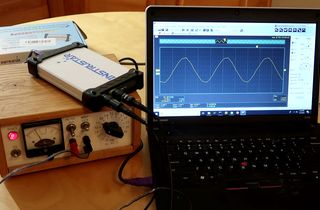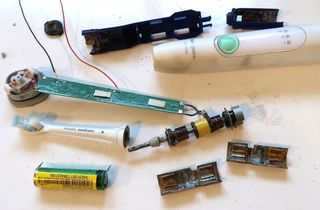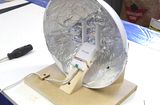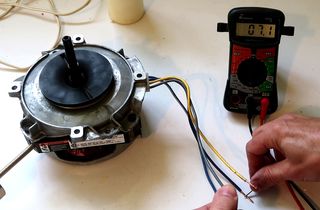 Squirrel shooter fail (video only, 2019)
Squirrel shooter fail (video only, 2019) My imgcomp program (motion triggered time-lapses, 2016)
My imgcomp program (motion triggered time-lapses, 2016)
I often have this problem. I have a headless (no monitor or keyboard) Raspberry Pi, put a flash card in already configured for my network (using another Raspberry Pi), and it connects to my network. But I don't what IP address my DHCP server assigned to it, so I can't connect to it via SSH or WWW.
I can look on my router to see what address was just assigned, but that's awkward and not practical if it's on someone else's Wi-Fi network.
So I wrote this Python script which blinks the last digits of the IP address on the built-in status LED of a Raspberry Pi after boot up. But rather than using Morse code (too complicated), I blink it out the digits as roman numerals, with 'I' (1) being a short blink, 'V' (5) being a medium long blink and 'X' (10) as a long blink. I use X to represent the digit zero. That way I don't have to try to count 8 or 9 blinks sometimes.
Each decimal digit is blinked separately, so 102 is blinked as I X II, not CII
If the second last octet of the IP4 address is a zero (which it usually is), it is omitted.
So if my Pi is assigned 192.168.0.249, it will only blink "249".
If it were assigned, 10.10.5.0, it would blink '5' and '0'.
If there is no IP address, it blinks "000"
Sometimes Wi-Fi will initialize with a bogus IP address but not connect, in which case, you may recognize that the last two octets blinked out don't match your network at all.
Example blink patterns:
| IP4 address | Digits blinked | Roman digits | Blink pattern | ||||||||||||
|---|---|---|---|---|---|---|---|---|---|---|---|---|---|---|---|
| 192.168.0.105 | |
| 192.168.2.349 |
| 10.10.456.789 |
| None (just 127.0.0.1) |
| |
Short blinks (I) are 0.1 seconds long
Medium blinks (V) are 0.4 seconds long
Long blinks (X) are 1.2 seconds long.
Time between digits is 1 second.
Time between octets is 2 seconds.
The IP address is blinked after boot completes, waiting for Wi-Fi to initialize. The IP address is blinked ten times, with a three second pause between. After that the status LED is returned to its default functionality, to blink on flash card access. On Raspbery Pi zero W, there is only one green LED used for power and status, so it blinks that one. On other Pi's, it blinks the green status LED.
The script needs to run as root. If you run it, it will check hat it has an IP which isn't changing,
then blinks the IP address. There is also an "install" option to add it to root's crontab
to make it run at startup.
To set it up to run at boot, from the directory that you put blink_ip.py into, just run:
sudo ./blink_ip.py install
You can get this this script from github here
https://github.com/Matthias-Wandel/pi_blink_ip
Or by typinggit clone https://github.com/Matthias-Wandel/blink_ip
or via this link: http://woodgears.ca/tech/blink_ip.py
This isn't the first program written to do this, but I couldn't find one that I thought
was useful. The solutions I found would blink every digit of the whole address (too hard to decode),
blink numbers like '9' with Morse code or nine blinks (too hard to count), use an external
LED instead of status LED (too inconvenient), and weren't set up to figure out the IP address
at startup, and so on. So I wrote this one to be the best IP address blinker there is!
https://www.raspberrypi.org/blog/what-the-blink-is-my-ip-address/
And as with my video, lots of comments to the effect of "why not just use method ___ instead". There are other methods, yes. I wasn't aware that DHCP servers these days will allow you to just refer to hostname.local (where hostname is the network name of the device). If I had known this, I might not have published this script. But I still like to have this script on all my pi's lying around. That way, when I power one up, I can just look at it to figure out what the address of THIS Raspberry Pi is. No need to install an app on a phone, figure out the MAC address, check the DHCP server or any of it, or figure out what hostname I happen to have this Pi configured to.
 Squirrel shooter fail (video only, 2019)
Squirrel shooter fail (video only, 2019) My imgcomp program (motion triggered time-lapses, 2016)
My imgcomp program (motion triggered time-lapses, 2016)
 The cheapest USB scope I could find (video only, 2019)
The cheapest USB scope I could find (video only, 2019) What's inside a Sonicare toothbrush (video only, 2019)
What's inside a Sonicare toothbrush (video only, 2019) Braun hand mixer speed control fix (video only, 2019)
Braun hand mixer speed control fix (video only, 2019) Wifi antenna
Wifi antenna Figuring out a mystery motor (video only, 2019)
Figuring out a mystery motor (video only, 2019) Does dusting out a fridge reduce power? (video only, 2019)
Does dusting out a fridge reduce power? (video only, 2019)